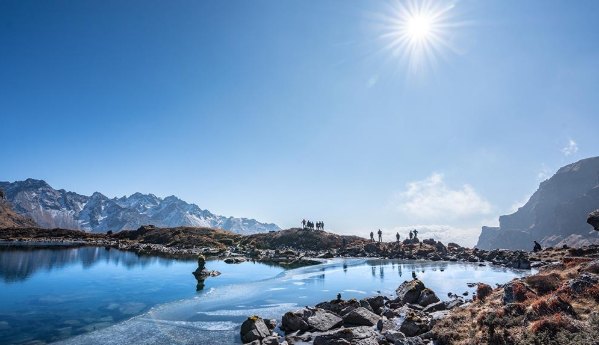The Kanchenjunga Base Camp Trek is one of Nepal’s most remote, challenging, and rewarding Himalayan adventures. Named after Mount Kanchenjunga (8,586 meters)—the world’s third-highest mountain—this trek takes you deep into the eastern Himalayas, where ancient cultures, untouched landscapes, and towering peaks create an unforgettable experience. Unlike more commercialized routes such as Everest or Annapurna, the Kanchenjunga region offers true solitude and authenticity for trekkers who crave exploration in its purest form.
Overview of the Kanchenjunga Region
Located on Nepal’s far eastern border with India and Tibet, the Kanchenjunga Conservation Area spans over 2,000 square kilometers of pristine wilderness. It is a region of immense biodiversity, with dense forests, alpine meadows, glacial valleys, and snow-covered peaks. The area was officially opened to foreign trekkers in 1988 and remains one of Nepal’s least crowded trekking destinations.
The word Kanchenjunga translates to “The Five Treasures of the Great Snow”, representing the five summits of the mountain believed to contain treasures of gold, silver, gems, grain, and holy scriptures. To the locals, Kanchenjunga is not just a mountain—it is a sacred guardian of the region, deeply woven into the spiritual beliefs of the Limbu and Rai communities.
Highlights of the Kanchenjunga Base Camp Trek
- Awe-inspiring views of Mount Kanchenjunga (8,586m), the third-highest peak in the world.
- A journey through remote villages, where ancient Tibetan-Buddhist and Kirati traditions are preserved.
- Crossing high mountain passes such as Sele La (4,290m) and Mirgin La (4,663m).
- Visiting both North and South Base Camps, each offering unique perspectives of the massif.
- Rich biodiversity within the Kanchenjunga Conservation Area, home to snow leopards, red pandas, and Himalayan black bears.
- Immersive cultural encounters with Sherpa, Rai, and Limbu communities.
This trek is a rare combination of adventure, culture, and untouched natural beauty—ideal for trekkers seeking something beyond the ordinary.
Typical Itinerary
The Kanchenjunga Base Camp Trek usually takes 21 to 25 days, depending on your route and pace. Below is a general outline covering both North and South Base Camps:
Day 1: Flight from Kathmandu to Bhadrapur, drive to Taplejung.
Day 2–4: Trek from Taplejung to Amjilosa, passing through lush subtropical forests and terraced hillsides.
Day 5–7: Continue to Ghunsa (3,475m), the main Sherpa village of the region. Spend an extra day for acclimatization and explore nearby monasteries.
Day 8–10: Trek to Kambachen and Lhonak, offering stunning views of Jannu (7,710m) and the glaciers of Kanchenjunga.
Day 11: Reach Pangpema (5,140m)—the North Base Camp of Kanchenjunga—the highlight of the trek with breathtaking panoramic views.
Day 12–13: Return to Ghunsa and trek toward the Sele La Pass.
Day 14–16: Cross Sele La and Mirgin La Passes, descending toward Tseram and the South Base Camp area.
Day 17: Visit Oktang (4,730m) for close-up views of Kanchenjunga’s South Face and Yalung Glacier.
Day 18–22: Descend via Torongden, Yamphudin, and Khebang, before returning to Taplejung and driving back to Bhadrapur or Kathmandu.
This circuit covers both faces of Kanchenjunga, offering a complete and immersive trekking experience.
Difficulty Level and Fitness
The Kanchenjunga Base Camp Trek is classified as strenuous. It requires good physical fitness, stamina, and mental endurance. Daily walking ranges from 6 to 8 hours, often through rugged trails, steep ascents, and high mountain passes above 4,000 meters.
While no technical climbing is needed, the remoteness of the route means that trekkers must be self-reliant and prepared for basic conditions. It’s highly recommended to trek with an experienced guide and porter team for safety and navigation.
Preparation tips:
- Train at least 6–8 weeks before the trek (focus on cardio, strength, and endurance).
- Acclimatize properly and stay hydrated to prevent altitude sickness.
- Carry lightweight yet warm clothing suitable for sub-zero temperatures.
Best Time to Trek
The ideal seasons for the Kanchenjunga Base Camp Trek are spring (March to May) and autumn (September to November).
- Spring: The trails come alive with blooming rhododendrons, lush greenery, and clear weather.
- Autumn: Offers crisp air, clear skies, and the best mountain visibility.
Winter (December–February) brings heavy snowfall at higher altitudes, while monsoon (June–August) can make lower trails muddy and leech-infested. However, for those seeking solitude, early winter offers magical snowy landscapes and near-empty trails.
Permits and Regulations
Because the Kanchenjunga region is a restricted area, trekkers need special permits and must travel with a registered trekking agency. Independent trekking is not allowed.
Required permits include:
- Restricted Area Permit (RAP) – USD 20 per week (minimum of two trekkers required).
- Kanchenjunga Conservation Area Permit (KCAP) – NPR 2,000 per person.
- TIMS Card (Trekkers’ Information Management System) – NPR 2,000.
A licensed guide is mandatory, and your trekking agency will handle all permit procedures.
Accommodation and Meals
Unlike the more developed trails of Everest or Annapurna, the Kanchenjunga Circuit offers basic teahouse accommodations with simple rooms and limited facilities. Expect shared rooms, traditional food, and warm local hospitality.
Meals are primarily local, including:
- Dal Bhat (rice, lentil soup, and curry)
- Momos (dumplings)
- Tibetan bread, eggs, and noodles
- Tea, coffee, and seasonal vegetables
As you ascend, food variety decreases, and prices rise due to remoteness. Trekkers should carry extra snacks, energy bars, and water purification tablets.
Culture and People
The cultural richness of the Kanchenjunga region is one of its most rewarding aspects. The lower region is inhabited by Rai, Limbu, and Gurung communities, known for their distinct traditions and folklore. As you ascend, you enter the world of Tibetan-influenced Sherpa and Bhote communities who practice Buddhism.
Monasteries, chortens, mani walls, and prayer flags line the trail, symbolizing peace and spirituality. The people here live simple lives, relying on agriculture, livestock, and small-scale trade with Tibet. Their warmth and hospitality make every stop along the trek memorable
Natural Beauty and Wildlife
The Kanchenjunga Conservation Area is a biodiversity hotspot, home to rare and endangered species such as the snow leopard, red panda, Himalayan black bear, blue sheep, and musk deer. The forests are lush with rhododendrons, oak, pine, and bamboo, gradually giving way to alpine meadows and glaciers at higher altitudes.
The scenery constantly evolves—from tropical river valleys to icy Himalayan landscapes. Each turn of the trail reveals a new perspective of Kanchenjunga’s mighty peaks, making this trek a paradise for photographers and nature lovers alike
Cost and Logistics
The Kanchenjunga Base Camp Trek costs between USD 1,800 and USD 2,500 per person, depending on group size, duration, and services.
Typical inclusions:
- All necessary permits and local taxes
- Licensed guide and porter services
- Accommodation and meals during trek
- Ground and domestic air transportation
- Agency fees and logistics support
Exclusions may include:
- Personal insurance and medical evacuation
- Alcoholic beverages or personal snacks
- Tips for guide and porter
Given its remoteness, it’s essential to trek with a trusted agency that ensures safety, proper permits, and local support.
Why Choose the Kanchenjunga Base Camp Trek
The Kanchenjunga Base Camp Trek stands apart for its untouched wilderness, cultural authenticity, and spiritual aura. It’s not just a physical journey but a deep exploration of Nepal’s wildest frontiers.
Unlike busier routes, Kanchenjunga offers tranquility and solitude, allowing trekkers to connect fully with nature and themselves. The breathtaking scenery, genuine human encounters, and sense of adventure make it one of Nepal’s most rewarding long-distance treks.
It’s ideal for trekkers who:
- Seek off-the-beaten-path adventure in remote Nepal.
- Want to experience both cultural and natural diversity.
- Have prior trekking experience and physical endurance.
Conclusion
The Kanchenjunga Base Camp Trek is a journey of discovery—of hidden valleys, ancient cultures, and the mighty Himalayas. It challenges you physically, rewards you spiritually, and immerses you in one of the world’s most pristine mountain environments.
For those who yearn for an authentic Himalayan experience far from the crowds, this trek delivers in every way. Standing at the foot of Kanchenjunga, surrounded by its towering peaks and endless silence, you realize why this sacred mountain is called one of the Five Treasures of the Great Snow—a place where nature, spirit, and adventure converge.

